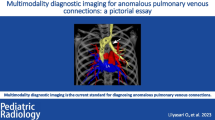Abstract
Pulmonary venous abnormalities are generally diagnosed by echocardiography and often confirmed by cardiac catheterization. Although angiography has been the gold standard for evaluation it carries certain inherent risks, especially in small and sick infants. In this study we retrospectively assessed the utility of magnetic resonance angiography (MRA) and computed tomography angiography (CTA) in the evaluation of pulmonary venous abnormalities in pediatric patients. The results were compared with operative findings. We reviewed nine patients with total APVC and four with partial APVC. Twelve patients were infant (age range: 1 day to 8 months) and the other was 16 years old. MRA and/or CTA clearly visualized the anomalous drainage of pulmonary veins in all patients. Cardiac catheterization was performed five patients with one total anomalous pulmonary venous connection and four with partial anomalous pulmonary venous connection. Ten patients were operated on. Diagnoses of patients were confirmed by operative findings. In Conclusions, MR and CT angiography allow detailed and comprehensive evaluation of the APVC and are good diagnostic modalities for use in the preoperative assessment of the anomaly in pediatric patients.




Similar content being viewed by others
References
Anderson RH, Macartney FJ (2002) Pulmonary venous abnormalities. In: Anderson RH, Baker EJ, Macartney FJ, Rigby ML, Shinebourne EA, Tynan M (eds) Paediatric Cardiology, 2nd edn. Churchill Livingstone, London, pp 867–899
Delisle G, Ando M, Calder AL et al (1976) Total anomalous pulmonary venous connection: report of 93 autopsied cases with emphasis on diagnostic and surgical considerations. Am Heart J 91:99–122
Friesen CLH, Zurakowski D, Thiagarajan RR et al (2005) Total anomalous pulmonary venous connection: an analysis of current management strategies in a single institution. Ann Thorac Surg 79:596–606
Michielon G, Di Donato RM, Pasquini L et al (2002) Total anomalous pulmonary venous connection: long-term appraisal with evolving technical solutions. Eur J Cardiothorac Surg 22:184–191
Turley K, Tucker WY, Ullyot DJ, Ebert PA (1980) Total anomalous pulmonary venous connection in infancy: influence of age and type of lesion. Am J Cardiol 45:92–97
Hijii T, Fukushige J, Hara T (1998) Diagnosis and management of partial anomalous pulmonary venous connection. Cardiology 89:148–151
Meter CV, LeBlanc JG, Culpepper WS, Ochsner L (1990) Partial anomalous pulmonary venous return. Circulation 18:195–198
Hsu YH, Chien CT, Hwang M, Chiu IS (1991) Magnetic resonance imaging of total anomalous pulmonary venous drainage. Am Heart J 125:1560–1565
Romero-Cardenas A, Vargas-Barron J, Rylaarsdam M et al (1991) Total anomalous pulmonary venous return: diagnosis by transesophageal Echocardiography. Am Heart J 121:1831–1834
Sreeram N, Walsh K (1992) Diagnosis of total anomalous pulmonary venous drainage by Doppler color flow imaging. J Am Coll Cardiol 19:1577–1582
Didier D, Higgins CB, Fisher MR et al (1986) Congenital heart disease: gated MR imaging in 72 patients. Radiology 158:227–235
Masui T, Seelos KC, Kersting-Sommerhoff BA, Higgins CB (1991) Abnormalities of the pulmonary veins: evaluation with MR imaging and comparison with cardiac angiography and Echocardiography. Radiology 181:645–649
Ritter S, Tani LY, Shaddy RE, Pagotto LT, Minich LL (2000) An unusual variant of total anomalous pulmonary venous connection with varices and multiple drainage sites. Pediatr Cardiol 21:289–291
Chandran A, Fricker FJ, Schowengerdt KO et al (2005) An institutional review of the value of computed tomographic angiography in the diagnosis of congenital cardiac malformations. Cardiol Young 15:47–51
Kim TH, Kim YM, Suh CH (2000) Helical CT angiography and three-dimensional reconstruction of total anomalous pulmonary venous connections in neonates and infants. AJR Am J Roentgenol 175:1381–1386
Lilje C, Weiss F, Weil J (2005) Detection of partial anomalous pulmonary venous connection by magnetic resonance imaging. Pediatr Cardiol 26:490–491
Sridhar PG, Kalyanpur A, Suresh PV, Collin J, Sharma R, Maheshwari S (2003) Total anomalous pulmonary venous connection: helical computed tomography as an alternative to angiography. Indian Heart J 55:624–627
Tutar E, Fitöz S, Atalay S et al (2005) Magnetic resonance angiographic and three-dimensional computerized tomographic identification of scimitar syndrome in an 8-month-old infant. Turk J Pediatr 47:92–94
Juraszek AL, Cohn H, Van Praagh R, Van Praagh S (2005) Isolated left-sided scimitar vein connecting all left pulmonary veins to the right inferior vena cava. Pediatr Cardiol 26:846–847
Posniak HV, Dudiak CM, Olson MC (1993) Computed tomography diagnosis of partial anomalous pulmonary venous drainage. Cardiovasc Intervent Radiol 16:319–320
Shiraishi I, Yamagishi M, Iwasaki N, Toiyama K, Hamaoka K (2001) Helical computed tomographic angiography in obstructed total anomalous pulmonary venous drainage. Ann Thorac Surg 71:1690–1692
Thorsen MK, Erickson SJ, Mewissen MW, Youker JE (1990) CT and MR imaging of partial anomalous pulmonary venous return to the azygos vein. J Comput Asist Tomogr 14:1007–1009
Ferrari VA, Scott CH, Holland GA, Axel L, Sutton MS (2001) Ultrafast three-dimensional contrast-enhanced magnetic resonance angiography and imaging in the diagnosis of partial anomalous pulmonary venous drainage. J Am Coll Cardiol 37:1120–1128
Prasad SK, Soukias N, Hornung T et al (2004) Role of magnetic resonance angiography in the diagnosis of major aortopulmonary collateral arteries and partial anomalous pulmonary venous drainage. Circulation 109:207–214
Author information
Authors and Affiliations
Corresponding author
Rights and permissions
About this article
Cite this article
Uçar, T., Fitoz, S., Tutar, E. et al. Diagnostic tools in the preoperative evaluation of children with anomalous pulmonary venous connections. Int J Cardiovasc Imaging 24, 229–235 (2008). https://doi.org/10.1007/s10554-007-9246-4
Received:
Accepted:
Published:
Issue Date:
DOI: https://doi.org/10.1007/s10554-007-9246-4




